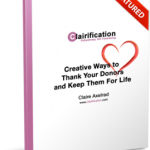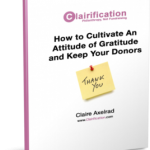
Do you toss good manners, along with common sense, out the window when you cross the threshold of your nonprofit?
Why and How to Invoke the Power of Thank You
My mother was known for having impeccable manners. At her memorial service, it seemed as if every other person who shared a memory talked about her manners. They did so not in a nitpicking way, but in a loving way. It seemed she always knew just the right thing to do to show her appreciation.
Maybe that’s why I love writing thank you notes. Seriously, it’s my favorite thing to do in all of fundraising. And it’s undoubtedly why, when I first heard Penelope Burk speak in 2001, it completely changed my approach to the practice of development.
Given Penelope’s research and the latest data on donor retention [See this benchmarking report, conducted by Blackbaud, showing that a whopping 70% of first-time donors – Wowie Zowie!–won’t give again] you should change your approach too. Why? Because the studies show donor satisfaction with the quality of service provided by the fundraising team is the single biggest driver of loyalty toward your organization. And what “service” do donors most care about? A prompt, personal thank you.
Yup. It’s that simple. One-time gifts are here today, gone tomorrow. Transactions won’t help you next year or the year after that. No. You’ve got to transform the transactions into something longer lasting.
The power of thank you is indisputable. It turns out there’s nothing like gratitude. Stop for a moment to think about the last time someone let you know they were grateful for something you did. Really think. Okay… got something? How did it make you feel?
Chances are it made you feel just a little bit warm and fuzzy towards the person expressing the gratitude. “More than any other emotion, gratitude is the emotion of friendship,” says Dr. Michael McCullough of the University of Miami in A Serving of Gratitude May Save the Day. “Gratitude is what happens when someone does something that causes you to realize that you matter more to that person than you thought you did.”
This is precisely how you want your donors to feel after they make a gift to you. And it’s why it’s so important you think beyond fundraising to encompass friendraising. A one-time donor is just that. But a friend? Now that’s someone who will become a loyal, ongoing support for you – someone you can count on through thick and thin. Great stuff, yes?
But wait, there’s more.
Thanking your donors will yield innumerable benefits [Check out this graphic or some of the findings from 40 research studies on gratitude]. This isn’t the place to get all touchy-feely and spiritual on you. After all, this is an article to help you improve your fundraising results. But if you read just a little of this research it’s quite an eye-opener. You’ll begin to wonder why we spend so little time on thanking and so much on asking. Gosh darn it! Asking makes many folks feel just lousy. Thanking elevates folk’s self-esteem and optimism. Of course, I’m not suggesting you stop asking. It’s just that after you’ve been thanking, thanking, thanking you’ll feel much more pumped up and capable of making an ask. Really – I’ve seen this happen time and again when I’ve asked reluctant volunteer solicitors to begin with thank-you calls. They graduate to solicitation calls in no time!
Bottom line: Gratitude makes us happier – both being grateful and receiving thanks has this effect. How cool is that? [See The 31 Benefits of Gratitude You Didn’t Know About: How Gratitude Can Change Your Life]. And one more thing. If you don’t’ get yourself a great thank you program you’ll be like the typical charity and lose 50 – 70% of your annual donors between the first and second donation, and up to 30% annually thereafter. Is that acceptable to you? I didn’t think so!
Here are just a few of the magical things gratitude does according to the research:
- It makes people like you. You want your donors to like you, don’t you? It deepens friendships. If they like you, they may stay with you.
- It helps people experience good feelings. If your donors feel good after they give to you, they may give again.
- It encourages pro-social behavior. This is the very heart and soul of philanthropy – love of humankind, and doing unto others as you would have them do unto you.
- It makes you less self-centered. The very nature of gratitude is to focus on others (on their acts of benevolence). When you sincerely appreciate your donors it makes it easier to sincerely appreciate your donors. Get it? This is for real folks. It’s not a ploy. Thanking begets thanking, just as giving begets giving. So give some thanks, okay?
- It boosts your productivity. Rather than taking away from your overall effectiveness (yes, I heard you saying you don’t have time for this stuff) it helps you network, enhances your decision making capabilities, increases your productivity and generally helps you achieve your career goals. Simultaneously, it makes your workplace a more friendly and enjoyable place to be. Nice, no?
- It makes you more optimistic. The act of gratitude is the act of focusing on the good in life. If you thank your $25 donor as if they were a $1000 donor you’ll perceive your current life to have more good. This leads you to also believe your future will have more good. Such optimism is contagious and will cause others to want to be a part of your life (and the life of your cause).
- It increases self-esteem. Gratitude has been shown in multiple studies to make people kinder and more friendly. Because of this, grateful people have more social capital. This means that grateful people are actually more likely to receive help from others – for no reason other than that they are liked and appreciated. Since help is exactly what you’ll want to be asking your donors for later on down the line, it’s clear how channeling an attitude of gratitude can work in your favor.
- It makes you look good. This is where we get back to good manners. It’s simply perceived as rude not to say thank you for a gift bestowed. The converse is also true. Ingratitude is universally regarded with contempt – and it’s one of the chief reasons donors stop giving to you.
Practicing gratitude is good for you too, not just your donors. There are oodles of documented benefits – from keeping you away from the doctor to boosting energy, making you more resilient, helping you exercise and giving you a good night’s sleep. But you’ve got to do it consistently.
You can’t just do it once; then stop. According to the research cited above, a one-time act of thoughtful gratitude produced an immediate 10% increase in happiness and 35% reduction in depressive symptoms, but the effects disappeared within six months and three months, respectively. If you want to continue to feel satisfied in your work with donors (and, as a corollary, if you want your donors to stay uplifted by their philanthropy), then you’ve got to practice gratitude as a way of life.
That’s why you need an intentional donor acknowledgement program that drips the gratitude throughout the year. You’ll feel better, and your donors will too. Gratitude is contagious. Nothing else will keep your donors in as continually a receptive mood.
I’ve Got 3 Great Resources to Help You Boost Your Gratitude Quotient and Keep More Donors!
#1  If you’re happy with your system, but just feel you’re getting a bit stale, check out my newly expanded Creative Ways to Thank Your Donors. Satisfaction is guaranteed!
If you’re happy with your system, but just feel you’re getting a bit stale, check out my newly expanded Creative Ways to Thank Your Donors. Satisfaction is guaranteed!
 #2 Get my comprehensive Attitude of Gratitude Donor Guide, which now includes the Creative Ways to Thank Your Donors. If you do, I promise you’ll raise more money every year from here on out. It’s filled with tips, templates, checklists and samples to help you apply what you learn RIGHT AWAY.
#2 Get my comprehensive Attitude of Gratitude Donor Guide, which now includes the Creative Ways to Thank Your Donors. If you do, I promise you’ll raise more money every year from here on out. It’s filled with tips, templates, checklists and samples to help you apply what you learn RIGHT AWAY.
#3 If you want to get your entire organization on board, why not gather a few key team members together and take my 4-Week E-Course, The Power of Thank You, together? I’m honored to be teaching with Pamela Grow, so you get two experts for the price of one. Plus BONUS webinars, podcasts, tutorials, e-books and other specialties galore. Don’t delay. Registration closes after May 16th – Grab the ‘Early Bird” Discount until May 9th. You’ll love all these products, I promise (or your money back). But this one’s a real steal!
Image courtesy of Freedigitalphotos.net







Claire,
I enjoy reading your articles. If we have thousands of small direct mail donors who give gifts of 5-$25, what is the most practical way to thank these donors?
Thanks for your comment Donna. If you have thousands of small donors it probably is impractical to thank them by phone. Yet I’d still recommend sending a letter in the mail. Many folks who respond to direct mail are also the type who love to receive mail. Getting something from you that’s prompt and personal will assure they make a second gift. And a third. And so forth. And guess what one of the strongest indicators of someone who leaves a legacy is? Yes! Continuous donors of small gifts are among the largest sources of unexpected bequests to charity. What goes around comes around.